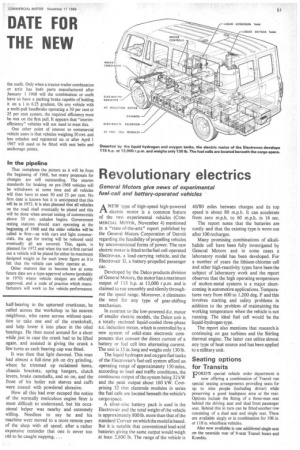Revolutionary electrics
Page 53

If you've noticed an error in this article please click here to report it so we can fix it.
General Motors give news of experimental fuel-cell and battery-operated vehicles
ANEW type of high-speed high-powered electric motor is a common feature of the two experimental vehicles (COMMERCIAL MOTOR, November 4) mentioned in a "state-of-the-arts" report published by the General Motors Corporation of Detroit regarding the feasibility of propelling vehicles by unconventional forms of power. The new electric motor is fitted to the fuel-cell-operated Electrov an, a load-carrying vehicle, and the Electrovair II. a battery-propelled passenger car.
Developed by the Delco products division of General Motors, the motor has a maximum output of 115 h.p. at 13,000 r.p.m. and is claimed to run smoothly and silently throughout the speed range. Moreover, it eliminates the need for any type of gear-shifting mechanism.
In contrast to the low-powered d.c. motor of smaller electric models, the Delco unit is a totally enclosed liquid-cooled three-phase a.c. induction motor, which is controlled by a new system of solid-state electronic components that convert the direct current of a battery or fuel cell into alternating current. The unit is 15 in. long and weighs only 130 lb.
The liquid hydrogen and oxygen fuel tanks of the Eleetrovan's fuel-cell system afford an operating range of approximately 150 miles, according to load and traffic conditions, the continuous output of the system being 32 kW and the peak output about 160 kW. Comprising 32 thin electrode modules in series the fuel cells are located beneath the vehicle's cargo space. A silver-zinc battery pack is used in the Electrovair and the total weight of the vehicle is approximately 800 lb. more than that of the standard Corvair on which the model is based. But it is notable that conventional lead-acid batteries giving the same output would weigh at least 2.600 lb. The range of the vehicle is .40/80 miles between charges and its top speed is about 80 m.p.h. It can accelerate from zero m.p.h. to 60 m.p.h. in 16 sec. The report notes that the batteries are costly and that the existing type is worn out after 100 recharges.
Many promising combinations of alkalihalide cell have been fully investigated by General Motors and in some cases a laboratory model has been developed. For a number of years the lithium-chlorine cell and other high-reactivity types have been the subject of laboratory work and the report observes that the high operating temperature of molten-metal systems is a major shortcoming in automotive applications. Temperatures vary from 600 to 1,200 deg. F and this involves starting and safety problems in addition to the problem. of maintaining the working temperature when the vehicle is not running. The ideal fuel cell would be the liquid-hydrogen type.
The report also mentions that research is continuing on gas turbines and the Stirling thermal engine. The latter can utilize almost any type of heat source and has been applied to a military unit.
































































































































